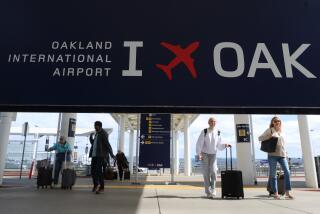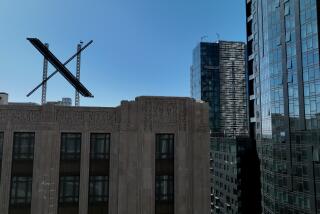How to Avoid Bottleneck at San Francisco International
Book yourself two round-trip flights involving San Francisco International Airport in less than a month, and odds are you’ll find yourself with time to do some thinking.
So it was for me recently. Burbank to SFO, July 28, United: delayed, causing me to miss a northbound connection and lose several hours. Eureka-Arcata to SFO, July 31, United Express: delayed by about two hours, again causing a missed connection. SFO to Burbank, also on July 31, United: delayed, but not horribly, which at this point felt like a victory.
Next came Burbank to SFO, Aug. 20, United: delayed by at least two hours, the airport TV monitor said.
I’ve always taken for granted the quick hop to the Bay Area, grateful that competition between United and Southwest keeps prices down. But during all this thinking time, I resolved to look up some U.S. Transportation Department figures on on-time performance at SFO this year. And the results are ugly.
In April, 79% of scheduled commercial flights nationwide arrived within 15 minutes of their scheduled time, but only 74% reached SFO on time (although 80% left on time). In May, it was worse: 78% of flights nationwide came in on time. But at SFO only 58% of flights arrived on time, while 70% departed on time. In June, with summer crowds clogging airports, about 70% of flights nationwide were on time. At SFO, only 53% of arrivals, and 69% of departures, were on time.
Meanwhile, at LAX, on-time performance beat SFO in five of those six categories. But that’s no comfort if you’re flying between the two, as did 2 million travelers last year.
I’ll get back to the reasons behind those numbers in a moment, but the point is that we travelers don’t have to put up with this.
As many West Coast business travelers have recognized for some time, there are alternative airports. San Jose’s airport may well be an option if you’re connecting elsewhere in the West. San Jose offers flights to 56 cities, and last week Shuttle by United began eight daily flights to Los Angeles. And for trips to Northern California or southern Oregon, there’s Portland. (Yes, Portland. During my considerable free time at the Eureka airport, I met locals who told me they urge visitors, even those coming from Southern California, to fly north into Oregon and then catch a Horizon Air puddle-jumper southbound into Eureka, all to avoid SFO.) The San Jose and Portland airports have substantially better punctuality records than SFO.
But the best alternative for anyone headed to San Francisco itself is Oakland, which also does much better with timeliness than SFO. The Oakland airport is 22 miles from downtown San Francisco (Avis car-rental clerks estimate the drive at 30 to 60 minutes); SFO is 13 miles from downtown (Avis estimates that drive, once again, at 30 to 60 minutes).
Back on Aug. 20, upon receiving word of my United flight’s delay to SFO, I strolled down the hall between the Burbank airport’s Terminal 1 and Terminal 2, booked myself onto a Southwest Airlines flight to Oakland about 40 minutes before takeoff, then strolled back and asked for a full refund on my United ticket to SFO. The last-minute Southwest round-trip ticket cost $36 more than the United ticket I had booked well in advance, but the Southwest flight got me to Oakland on time, more than an hour ahead of United’s most optimistic estimates.
Switching rental car reservations was easy. The Oakland airport is easier to navigate than SFO, and the drive to my destination in Marin County took the same time it would have from SFO.
What gums up the works at SFO? The airport has two sets of parallel runways, one pair for arrivals, one pair for departures, with the parallel strips set 750 feet apart. Federal Aviation Administration requirements dictate that when clouds over San Francisco Bay drop below 3,500 feet, air-traffic controllers must stagger landings. That can mean 30 landings per hour instead of 60. And because United’s flights between SFO and Los Angeles fly every hour, they are usually first in line to be canceled, with passengers forced onto later departures.
And this year “has been bad,” acknowledges San Francisco airport spokesman Michael McCarron. “We’ve had lower-than-normal cloud ceilings this year. In the spring, it was all El Nino related. And we’re not sure why, but for some reason, in June, July and August, we haven’t had that early burn-off [of fog].”
The airport has a $2.4-billion expansion in the works, but that won’t affect the runways. Airport officials are studying the idea of separating the runways so that they could accommodate simultaneous landings under cloud cover--but that would require filling in part of San Francisco Bay, a politically sensitive idea.
In the meantime, United Airlines, which flies about half of all the flights in and out of SFO, is left as (in the San Francisco Examiner’s words) “a lightning rod for customer rage.” Since United knows that airport’s track record, many passengers ask, why schedule flights so tightly and disappoint so many customers?
One answer is that we keep buying tickets.
Reynolds travels anonymously at the newspaper’s expense, accepting no special discounts or subsidized trips. He welcomes comments and suggestions, but cannot respond individually to letters and calls. Write Travel Insider, Los Angeles Times, Times Mirror Square, Los Angeles 90053 or e-mail chris.reynolds@latimes.com.
More to Read
Sign up for The Wild
We’ll help you find the best places to hike, bike and run, as well as the perfect silent spots for meditation and yoga.
You may occasionally receive promotional content from the Los Angeles Times.







